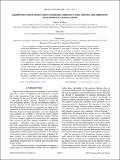Equilibrium-reduced density matrix formulation: Influence of noise, disorder, and temperature on localization in excitonic systems
Author(s)
Moix, Jeremy; Zhao, Yang; Cao, Jianshu
DownloadMoix-2012-Equilibrium-reduced density matrix formulation.pdf (680.1Kb)
PUBLISHER_POLICY
Publisher Policy
Article is made available in accordance with the publisher's policy and may be subject to US copyright law. Please refer to the publisher's site for terms of use.
Terms of use
Metadata
Show full item recordAbstract
An exact method to compute the entire equilibrium-reduced density matrix for systems characterized by a system-bath Hamiltonian is presented. The approach is based upon a stochastic unraveling of the influence functional that appears in the imaginary time path integral formalism of quantum statistical mechanics. This method is then applied to study the effects of thermal noise, static disorder, and temperature on the coherence length in excitonic systems. As representative examples of biased and unbiased systems, attention is focused on the well-characterized complexes of the Fenna-Matthews-Olson (FMO) protein and the light harvesting complex of purple bacteria, LH2, respectively. Due to the bias, FMO is completely localized in the site basis at low temperatures, whereas LH2 is completely delocalized. In the latter, the presence of static disorder leads to a plateau in the coherence length at low temperature that becomes increasingly pronounced with increasing strength of the disorder. The introduction of noise, however, precludes this effect. In biased systems, it is shown that the environment may increase the coherence length, but only decrease that of unbiased systems. Finally it is emphasized that for typical values of the environmental parameters in light harvesting systems, the system and bath are entangled at equilibrium in the single excitation manifold. That is, the density matrix cannot be described as a product state as is often assumed, even at room temperature. The reduced density matrix of LH2 is shown to be in precise agreement with the steady state limit of previous exact quantum dynamics calculations.
Date issued
2012-03Department
Massachusetts Institute of Technology. Department of ChemistryJournal
Physical Review B
Publisher
American Physical Society
Citation
Moix, Jeremy, Yang Zhao, and Jianshu Cao. “Equilibrium-reduced Density Matrix Formulation: Influence of Noise, Disorder, and Temperature on Localization in Excitonic Systems.” Physical Review B 85.11 (2012). ©2012 American Physical Society
Version: Final published version
ISSN
1098-0121
1550-235X